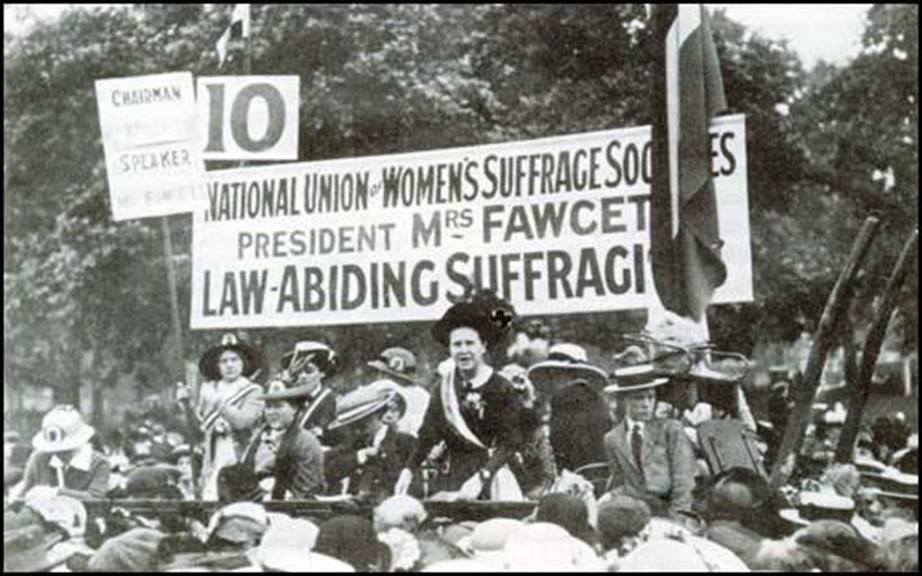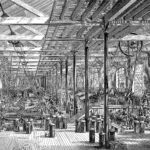The National Union of Women’s Suffrage Societies (NUWSS) played a key role in British history. It worked tirelessly for women’s right to vote.
The NUWSS was formed in 1897. It united various suffrage groups across the UK. Led by Millicent Fawcett, the NUWSS believed in peaceful protest. They held meetings, organized petitions, and worked to change laws. Unlike more militant groups, the NUWSS focused on education and lobbying.
Their efforts helped to change public opinion on women’s suffrage. Understanding the NUWSS gives us insight into the long struggle for women’s rights. It shows how determined efforts can lead to social change. Join us as we explore the important work of this historic organization.
Origins Of The Movement
The National Union of Women’s Suffrage Societies (NUWSS) played a key role in securing voting rights for women in the UK. Understanding its origins provides insight into the struggle for gender equality. The movement was shaped by early influences and driven by dedicated founding members.
Early Influences
The NUWSS did not emerge in isolation. Early influences were crucial in shaping its direction. The Industrial Revolution brought social changes, highlighting gender inequalities. Women began to demand more rights. Thinkers like Mary Wollstonecraft advocated for women’s education and rights. Her book, “A Vindication of the Rights of Woman,” inspired many. The Chartist Movement also played a role. It called for political reforms, including voting rights for men. Women saw the potential for their own cause. These early influences laid the groundwork for the NUWSS.
Founding Members
The NUWSS was founded by a group of dedicated individuals. Millicent Fawcett was a key figure. She believed in peaceful campaigning and education. Lydia Becker was another important member. She edited the Women’s Suffrage Journal, spreading the message. These founding members shared a vision. They wanted women to have the same political rights as men. Their dedication and hard work made the NUWSS a significant force in the suffrage movement.
Key Figures
The National Union of Women’s Suffrage Societies (NUWSS) played a vital role in the fight for women’s voting rights in the UK. Key figures within the NUWSS were instrumental in advancing the cause. Here, we focus on some of the most notable leaders who led the movement with dedication and passion.
Millicent Fawcett
Millicent Fawcett was the president of the NUWSS. She believed in peaceful protest and legal means to achieve suffrage. Under her leadership, the NUWSS grew in strength and numbers. Fawcett’s approach was to work within the system to create change. Her dedication and strategy were key to the group’s success.
Notable Leaders
| Name | Role | Contribution |
|---|---|---|
| Emmeline Pethick-Lawrence | Treasurer | Organized fundraisers and managed finances |
| Edith Palliser | Organizer | Coordinated marches and rallies |
| Maud Royden | Speaker | Gave inspiring speeches across the country |
These leaders were not alone. Many others contributed to the cause. The collective effort of these dedicated women brought about significant change. Their work laid the foundation for women’s rights today.
Strategies And Tactics
The National Union of Women’s Suffrage Societies used peaceful strategies and tactics to fight for women’s voting rights. They organized rallies, petitions, and public meetings to raise awareness. Their approach focused on legal reforms and gaining support from politicians.
The National Union of Women’s Suffrage Societies (NUWSS) employed strategic methods to achieve their goals. They believed in peaceful and lawful approaches. Their tactics were well-organized and effective.
Peaceful Protests
The NUWSS organized peaceful protests to demand the right to vote. These protests were orderly and disciplined. Women marched through the streets with banners. They held public meetings and gave speeches. Their aim was to raise awareness and gain support. They believed in winning hearts and minds through peaceful means.
Political Lobbying
Political lobbying was another key tactic used by the NUWSS. They engaged directly with politicians. They wrote letters and petitions to lawmakers. They also met with Members of Parliament to discuss their cause. Through lobbying, they aimed to influence legislation. They believed in working within the political system for change.
“`
Major Campaigns
The National Union of Women’s Suffrage Societies (NUWSS) played a key role in the fight for women’s voting rights. Their major campaigns were varied and impactful. They used different methods to promote their cause and gain public support.
Petitions And Rallies
Petitions were one of their primary tools. The NUWSS gathered thousands of signatures. They presented these petitions to Parliament. This showed the massive public support for women’s suffrage.
Rallies were another important method. The NUWSS organized large gatherings. These events drew attention to their cause. They held marches in big cities. Many people attended these rallies. The media covered these events, spreading their message further.
Media And Publications
The NUWSS used media to their advantage. They published articles in newspapers. These articles highlighted their struggles and goals. They also created their own publications. This helped them control their message. They distributed pamphlets and leaflets. These materials educated the public.
The NUWSS also used posters and banners. These visual tools were effective. They caught people’s attention. They made the message clear and memorable. Through media and publications, the NUWSS reached a wider audience.
Challenges Faced
The National Union of Women’s Suffrage Societies (NUWSS) faced many challenges. These obstacles tested their resolve and determination. Let’s explore the key challenges they encountered.
Opposition And Criticism
The NUWSS faced strong opposition from various groups. Many people believed women should not vote. They thought women belonged at home. Politicians often ignored their demands. Newspapers criticized their activities harshly. This negative attention made their work difficult. They had to stay strong despite the criticism.
Internal Conflicts
Internal conflicts were another challenge for the NUWSS. Members had different opinions on strategies. Some wanted a peaceful approach. Others believed in more aggressive actions. These disagreements caused tension within the group. They had to find common ground to move forward. Balancing these views was not easy. They needed unity to succeed.
Credit: en.wikipedia.org
Successes Achieved
The National Union of Women’s Suffrage Societies (NUWSS) achieved significant milestones. They advocated for women’s voting rights. Their efforts led to substantial changes in both legislation and society.
Legislative Victories
The NUWSS played a crucial role in passing key laws. One of their major successes was the Representation of the People Act 1918. This act granted voting rights to women over 30. It was a monumental victory for women’s rights.
Another significant milestone was the Equal Franchise Act of 1928. This act gave voting rights to all women over 21. It ensured equal voting rights for both men and women.
Broader Social Impact
The NUWSS did more than change laws. Their work had a broad impact on society. They raised awareness about women’s rights. They inspired other movements for gender equality. Their activism helped change societal views on women’s roles.
Additionally, the NUWSS created educational opportunities for women. They promoted women’s involvement in politics and public life. Their efforts led to more women participating in various sectors of society.
Their successes show the power of organized activism. The NUWSS left a lasting legacy on both legislation and society.
Legacy And Influence
The National Union of Women’s Suffrage Societies (NUWSS) has left a lasting legacy. This organization played a crucial role in the fight for women’s voting rights in the UK. Understanding its influence helps us see the importance of collective action and perseverance.
Impact On Future Movements
The NUWSS inspired many future movements. Its success showed that persistent, peaceful advocacy could lead to significant change. Many civil rights groups adopted similar strategies. The NUWSS’s structured campaigns and public demonstrations set a precedent. They proved that organized efforts could sway public opinion and policy.
Continued Relevance Today
The principles of the NUWSS remain relevant today. Modern equality movements draw from their playbook. Organized marches, petitions, and public speeches echo the NUWSS’s tactics. Their legacy lives on in every peaceful protest and advocacy campaign. These methods continue to empower voices worldwide.
The NUWSS also reminds us of the importance of unity. Their collective effort brought diverse groups together for a common cause. This unity continues to be a powerful tool in today’s social movements.
Commemorating The Nuwss
The National Union of Women’s Suffrage Societies (NUWSS) played a crucial role in the fight for women’s voting rights in the UK. Their tireless efforts laid the foundation for gender equality. Today, we honor their legacy through various commemorations, ensuring their sacrifices and achievements are remembered and celebrated.
Memorials And Tributes
To honor the NUWSS, numerous memorials and tributes have been established across the UK. These serve as constant reminders of the movement’s impact.
- Statues: Many cities feature statues of key NUWSS figures.
- Plaques: Commemorative plaques mark significant locations.
- Public Art: Murals and sculptures celebrate the movement.
These tributes not only preserve history but also educate the public about the NUWSS’s vital role in societal progress.
Educational Programs
Educational programs ensure the legacy of the NUWSS lives on. Schools, museums, and organizations offer various initiatives to teach about the suffrage movement.
- School Curricula: History lessons include the NUWSS’s contributions.
- Exhibitions: Museums host exhibitions on women’s suffrage.
- Workshops: Interactive workshops engage participants in learning.
These programs help new generations understand the significance of the NUWSS’s fight for equality.
By preserving their memory through memorials and educational programs, we ensure the NUWSS’s legacy continues to inspire future advocates for gender equality.

Credit: hist259.web.unc.edu
FAQs
What Is The National Union Of Women’s Suffrage Societies?
The National Union of Women’s Suffrage Societies (NUWSS) was a leading British women’s suffrage organization. It was founded in 1897 by Millicent Fawcett. The NUWSS aimed to achieve women’s voting rights through peaceful and lawful means.
Who Founded The National Union Of Women’s Suffrage Societies?
Millicent Fawcett founded the National Union of Women’s Suffrage Societies in 1897. She was a prominent suffragist and feminist. Her leadership was instrumental in the organization’s commitment to peaceful advocacy.
What Methods Did Nuwss Use For Suffrage?
The NUWSS used peaceful and lawful methods for advocating women’s suffrage. They organized petitions, meetings, and non-violent protests. They believed in lobbying and education to achieve their goals.
When Was The Nuwss Founded?
The National Union of Women’s Suffrage Societies was founded in 1897. It brought together various regional suffrage groups. The organization worked tirelessly for women’s voting rights.
Conclusion
The National Union of Women’s Suffrage Societies played a crucial role. They fought hard for women’s voting rights. Their efforts changed history. Women today enjoy rights because of their dedication. Remember their struggle and commitment. Their legacy inspires future generations.
Every vote now has a story behind it. Celebrate their achievements and honor their fight. The journey was long, but their victory was worth it. Let’s appreciate the pioneers of women’s suffrage. Their impact remains powerful and lasting.








